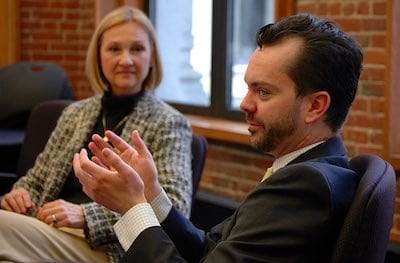
Christopher Gilrein (right) discusses energy policy and net metering as Charlton Town Administrator Robin Craver listens
MMA-supported legislation signed by the governor in April 2016 raised the solar “net metering” cap by 3 percent on public and private projects – to a total of 8 percent for public projects and 7 percent for private projects.
Since then, both public and private entities have been developing solar projects and taking advantage of net metering, which enables solar developers to sell some power back to utilities.
While the expanded cap on privately owned projects has already been met in two utility territories, and the other territories could be full by the end of the year, approximately 268,000 kilowatts remain available under the cap for public projects. This space under the public cap would be used for municipal solar projects that benefit from net metering and other solar incentives.
The MMA Policy Committee on Energy and the Environment has been meeting with stakeholders and industry experts about the obstacles and challenges that communities may face in participating in net metering under the current system.
On April 12, the committee heard from Christopher Gilrein, policy and regulatory manager at Clean Energy Collective, who stressed the need for a long-term fix for net metering caps, but also discussed an idea that could reduce the administrative burden and barrier to entry for municipalities.
Under current law, a public net-metering facility is defined as a facility that is owned or operated by a municipality (or governmental entity) where the owner, as the host customer, is assigned 100 percent of the output. Gilrein discussed the possibility of a legislative change to the definition of public facility in order to allow solar projects where the municipality is assigned at least 50 percent of the output. Municipalities, therefore, would not need to act as the host customer and could instead subscribe to just the amount of output they need.
Further, under Massachusetts law, public entities are limited to 10 megawatts of total solar ownership. If a city or town is a subscriber instead of the host customer, those projects would not count toward the municipality’s 10 megawatt cap.
To date, Gilrein noted, no legislation has been filed to make these changes, but the concept is being circulated for feedback from local officials.
The regulatory structure of solar incentives is also expected to change soon. The Department of Energy Resources has released the program design for a new Solar Massachusetts Renewable Target (SMART) program, and the department intends to file emergency regulations based on the design.
The SMART program will be a successor to the Solar Renewable Energy Credit (SREC) II program. The DOER has extended the SREC-II program, at a reduced value, until the new solar incentive program is in effect, which is not expected for at least another year.
According to officials at the DOER, the SMART program is designed to provide more revenue certainty. The program would be for 1,600 megawatts and would have a declining block structure. Base compensation rates for the program would be set according to project size and would be the same across the state. Base compensation rates would decline by set percentages in each block.
Local officials who are able to provide information on obstacles and challenges that municipalities face in participating in net metering projects, or who would like to share ideas to simplify the process or provide comments on the proposal presented to the committee, are asked to contact Victoria Sclafani at the MMA.
